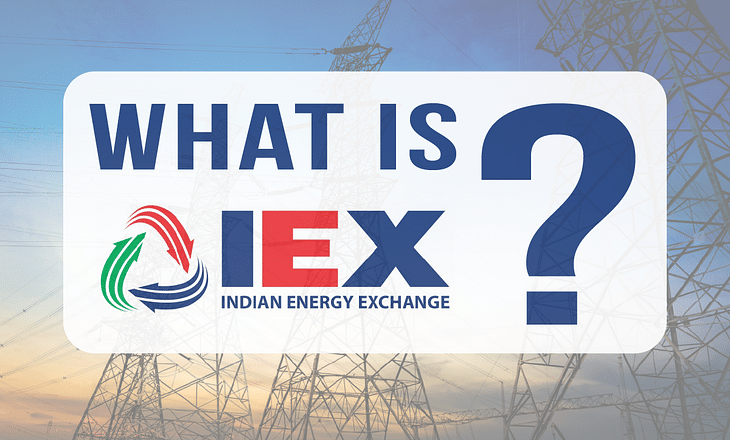What is the Indian Energy Exchange(IEX)? How Does it Work?

What is IEX?
The Indian Energy Exchange or IEX is an electronic power trading marketplace for electricity corporations and boards to trade contracts related to energy. In simple terms, just like how individuals can trade in the stock market to gain profit, electricity corporations can trade on the IEX to increase profitability and have better price discovery. It is a place where participants can buy and sell energy through a double-sided closed auction process.
State Electricity Boards, power-producing companies, power transmission companies, and power traders that have a huge capital trade on IEX. IEX is one of the only two power exchanges apart from Power Exchange India Limited(PXIL).
The IEX started operations in 2008. It is regulated by the Central Electricity Regulation Commission, which regulates the IEX just like how SEBI regulates the NSE and BSE.
How Does Trading Work On the IEX?
Say, for example, there is a shortage of power in Bangalore, which will increase the price of electricity and also eat into the profits of the electricity board. The electricity board will then log on to IEX and find out if another electricity board/transmission company/renewable energy company which offers a lower price. There will then be a bidding process for that segment. This way Bangalore's electricity board will be able to procure electricity at a lower rate. At the same time, the entity which sold the electricity will be able to make profits.
Products on the IEX trade on a normal demand-supply basis. There are 4 major products traded on the IEX:
Renewable Energy Certificates(REC) - An REC certifies that the bearer owns one megawatt-hour (MWh) of electricity generated from a renewable energy resource. Companies need to meet requirements related to show that they are not causing pollution and are meeting the environmental requirements. A REC helps them achieve this compliance which can later translate into government grants, profits, or lower taxation.
For example Ajay Renewables is a renewable energy company based out of Kochi, that sets up wind turbines, generates electricity, and then sells it to companies. The Government of India comes out with a subsidy plan where it gives Rs. 100 crores to any company that has generated more than 30 lakh megawatt-hours that year in green energy. Two months for year-end, Ajay Renewables has managed to generate only 29 lakh megawatt-hours that year. It does not have time to set up new wind turbines and meet the target. It approaches the IEX and buys 200,000 RECs in the spot market. This certifies that the company has produced 2 lakh megawatt-hours of power in renewable energy. Ajay Renewables ends up getting the Rs. 100 crores subsidy,
Energy Saving Certificates(ESCerts)- Energy Saving Certificates are similar to RECs, just that they represent one megawatt-hour (MWh) of energy saved from a project. These certificates can be bought and sold like normal certificates
Both EScerts and RECs can be bought and sold on the exchange by companies. This means that even if a company might be causing a lot of pollution, yet it buys enough of these certificates, it gets a clean chit.
Day-Ahead-Market (DAM) - It is a physical electricity trading market where power is delivered within 24 hours of the next day starting from midnight. They are traded in 15 minute time blocks The prices and quantum of electricity closed the auction bidding process.
Term-Ahead Market (TAM) - It provides a range of products allowing participants to buy/sell electricity on a term basis for a duration of up to 11 days ahead.
Real-Time Market (RTM) - In RTM, power is physically delivered within an hour of the bidding process.
Can I Trade on the IEX?
IEX isn't a ground for retail traders. The exchanges involves physical delivery of electricity. An individual may trade on the exchange provided he/she owns an establishment that requires tons of loads of power. Apart from this, the individual requires the necessary clearance from the CERC to be able to trade on the platform. According to the exchange guidelines, a member or a client should have a capital of atleast Rs. 150 Lakhs to be able to transact on the platform.
Looking Ahead
Energy exchanges provide an economic as well as environmental benefit. It provides a fair price discovery on electricity, at the same time encouraging companies to use green energy.
The IEX is listed on NSE and BSE. On average, 6000+ MW of power is traded daily on the exchange. The traded volume is growing at 32% CAGR. It has a consumer base of 4000+ Industries, 55+ Distribution companies, 100+ ESCert Entities, 500+ Generators, 1500+ renewable energy generators.
Apart from being an energy exchange, IEX is also an interesting company with interesting financials. The company has strong fundamentals as of now and with the Electricity Amendment Bill around the corner, things seem bright for the energy sector. We will be covering more in a company analysis of IEX. Stay tuned.
To know more about functioning of the IEX, check out their FAQ page, click here.


Post your comment
No comments to display